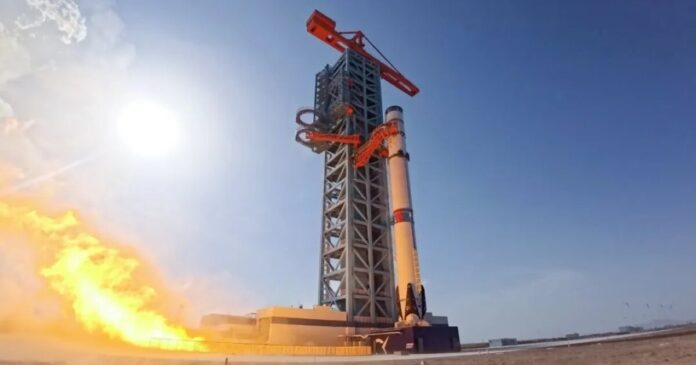China showed off its ambitions for space in the 21st century as its first reusable heavy booster, the ZhuQue-3 (ZQ-3) Y1 from the Landspace company, conducted its first static firing at the Jiuquan Satellite Launch Center in northwest China.
In the last two decades, China has become much more assertive of its ambitions to be the preeminent power in space this century. Already it has greatly increased its orbital launch capability and is the first country to send a satellite into orbit with a launcher using a methane-fueled first stage. However, its launch record is still streets behind the Americans, who dominate launches with China having only 25% of the global market compared to America’s 60%.
Part of the reason for US dominance is SpaceX’s development of both reusable rockets and heavy lift capabilities. Because China wants to not only dominate the launch market but land astronauts on the Moon by 2030, it hopes to emulate this capability by producing its own versions of SpaceX’s Falcon 9 and Starship.
The closest copy of SpaceX’s technology is Landscape’s ZQ-3, which combines the stainless steel construction of Starship with the multi-cluster engines, aerodynamic control flaps, and landing legs of the Falcon 9. Fueled by a combination of liquid oxygen and liquid methane, its goal is to duplicate SpaceX’s business model of radically reducing costs by up to 90% while ramping up launch cycles by reusing rocket stages up to 20 times instead of discarding them.
The latest tests from October 18 to 20 included a full-scale propellant rehearsal and a static-fire test, marking the XQ-3’s entry into final flight preparation, with the first flight slated for November or December 2025.
The ZQ-3 is a two-stage launcher that lifts off vertically and the first stage lands vertically. Standing about 216 ft (66 m) tall with a core diameter of 15 ft (4.5 m), it’s very similar to Falcon 9, though with methane fuel instead of kerosene for the first stage, and is made of stainless steel rather than aluminum/lithium alloy. Though only slightly smaller than Falcon 9, its reported orbital payload is only about half of the American launcher.
Though no date has been given for when the ZQ-3 will be operational, the first landing attempt is reported to be in 2026.
Source: Landspace


